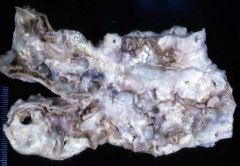![]()
![]()
![]()
Use LEFT and RIGHT arrow keys to navigate between flashcards;
Use UP and DOWN arrow keys to flip the card;
H to show hint;
A reads text to speech;
13 Cards in this Set
- Front
- Back
|
Describe the Pathogenesis of Atherosclerosis (i.e. "hardening of the arteries").
|
An endothelial injury leads to LDL infiltration into the vessel wall. The LDL is modified/oxidized leading to uptake and accumulation within Macrophages (foam cells). Once activated, the macrophages release inflammatory cytokines leading to activated T cells, monocyte recruitment and intimal migration of smooth muscle cells (atheroma formation). With accumulation in the tunica intima, there is progressive weakening of the tunica media.
|
|
|
IL6 is produced by (blank) during atherosclerosis leading to CRP and othe acute phase reactants.
|
Activated T Cells
|
|
|
Why do we fear plaque rupture?
|
Rupture can produce a thrombus leading to occlusion then ischemia.
|
|
|
What is the difference between a Risk Factor and a Risk Marker?
|
Risk Factor is causally linked to the disease, while a Risk Marker can be just a measure of the process and not causally linked.
|
|
|
Name Some Common Risk Factors for Heart Disease.
|
Cigarrettes, Cholesterol Level, EKG Abnormality, Lack of Exercise, Obesity, Age, Male Gender, Diabetes, BP, Menopause
|
|
|
Using the Framingham Risk Study, What 3 characteristics require intensive risk factor intervention?
|
High Risk is determined by Established CAD, DM, or >20% calculated risk.
|
|
|
Describe the lab values, doctors shoot for in managing these risk factors: LDL, BP and Glucose.
|
LDL <160; BP <140/90; Glucose FBS <110 mg/dl / HbA1c <7%
|
|
|
TRUE/FALSE - Arteriosclerosis is a generic term that encompasses atherosclerosis, a disease of large and medium arteries, & arterioloscelerosis, a disease of small arteries.
|
True
|
|
|
Describe the pathologic changes in Arterioloscerosis.
|
Hyaline and collagen deposition along with hyperplastic changes lead to loss of elasticity in the vessel wall and can lead to luminal narrowing.
|
|
|
Atherosclerosis is most prevalent in what 2 anatomical location?
|
abdominal aorta and coronary arteries
|
|
|
TRUE/FALSE - Aortic fatty streaks seen in virtually all children by age 10, regardless of geography, race, sex or environment
|
TRUE
|
|
|
Reference to several conditions including erosion, ulceration or fissuring, plaque hemorrhage, mural thrombosis, calcification, and aneurysm.
|

What does the term "complicated" plaque in advanced lesions imply?
|
|
|
What are the 3 predominant major complications in atherosclerosis?
|
The 3 predominant major complications are myocardial infarction, cerebral infarction and aortic aneurysm
|

